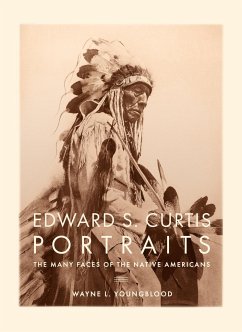- Gebundenes Buch
- Merkliste
- Auf die Merkliste
- Bewerten Bewerten
- Teilen
- Produkt teilen
- Produkterinnerung
- Produkterinnerung
Photographer Edward S. Curtis was a prolific photographer and recorder of Native American culture. Edward S. Curtis Portraits is a collection of his most moving cultural portraits.
Andere Kunden interessierten sich auch für
![Memoir Of Joseph Curtis Memoir Of Joseph Curtis]() Catherine Maria SedgwickMemoir Of Joseph Curtis37,99 €
Catherine Maria SedgwickMemoir Of Joseph Curtis37,99 €![Research and Education Research and Education]() Sam Shields (UK University of Hull)Research and Education44,99 €
Sam Shields (UK University of Hull)Research and Education44,99 €![General Curtis E. LeMay on Leadership and Command General Curtis E. LeMay on Leadership and Command]() Paul K. CarltonGeneral Curtis E. LeMay on Leadership and Command61,99 €
Paul K. CarltonGeneral Curtis E. LeMay on Leadership and Command61,99 €![Read Write Inc. Fresh Start Readers: Book 10: A Tour of Bikes & My Diary - by Curtis Read Write Inc. Fresh Start Readers: Book 10: A Tour of Bikes & My Diary - by Curtis]() Catherine BakerRead Write Inc. Fresh Start Readers: Book 10: A Tour of Bikes & My Diary - by Curtis9,99 €
Catherine BakerRead Write Inc. Fresh Start Readers: Book 10: A Tour of Bikes & My Diary - by Curtis9,99 €![Light - Science & Magic Light - Science & Magic]() Fil HunterLight - Science & Magic64,99 €
Fil HunterLight - Science & Magic64,99 €![Fine Art Wedding Photography Fine Art Wedding Photography]() J VillaFine Art Wedding Photography33,99 €
J VillaFine Art Wedding Photography33,99 €![Zen Camera: Creative Awakening with a Daily Practice in Photography Zen Camera: Creative Awakening with a Daily Practice in Photography]() D UlrichZen Camera: Creative Awakening with a Daily Practice in Photography26,99 €
D UlrichZen Camera: Creative Awakening with a Daily Practice in Photography26,99 €-
-
-
Photographer Edward S. Curtis was a prolific photographer and recorder of Native American culture. Edward S. Curtis Portraits is a collection of his most moving cultural portraits.
Hinweis: Dieser Artikel kann nur an eine deutsche Lieferadresse ausgeliefert werden.
Hinweis: Dieser Artikel kann nur an eine deutsche Lieferadresse ausgeliefert werden.
Produktdetails
- Produktdetails
- Verlag: Quarto Publishing Group USA Inc
- Seitenzahl: 256
- Erscheinungstermin: 5. Oktober 2023
- Englisch
- Abmessung: 310mm x 325mm x 25mm
- Gewicht: 1494g
- ISBN-13: 9780785839743
- ISBN-10: 0785839747
- Artikelnr.: 61775798
- Herstellerkennzeichnung
- Libri GmbH
- Europaallee 1
- 36244 Bad Hersfeld
- gpsr@libri.de
- Verlag: Quarto Publishing Group USA Inc
- Seitenzahl: 256
- Erscheinungstermin: 5. Oktober 2023
- Englisch
- Abmessung: 310mm x 325mm x 25mm
- Gewicht: 1494g
- ISBN-13: 9780785839743
- ISBN-10: 0785839747
- Artikelnr.: 61775798
- Herstellerkennzeichnung
- Libri GmbH
- Europaallee 1
- 36244 Bad Hersfeld
- gpsr@libri.de
Wayne Youngblood is a freelance author and editor with a broad variety of interests. He has written books on a range of subjects from colonial history and American Indians to stamps and stamp collecting. In addition, he has authored thousands of columns and features covering historical and collectible subjects. His specific awareness of Mathew Brady's work came from a longtime interest in early photography, the American Civil War, and US postage stamp design, for which numerous attributed and unattributed Brady photos have been used as sources.Ray Bonds has been a defense journalist, editor, and publisher during a career spanning over thirty five years, covering periods and activities as wide ranging as the American Civil War, anti-ballistic missile systems, stealth warfare, and modern military intelligence gathering. He has written and edited scores of well respected titles on the world's major armed forces, their battles, weapons, and organization, with a specialty in the armed services of the United States.
Introduction
I The Apache. The Jicarillas. The Navaho.
II The Pima. The Papago. The Qahatika. The Mohave. The Yuma. The Maricopa.
The Walapai. The Havasupai. The Apache-Mohave, or Yavapai
III The Teton Sioux. The Yanktonai. The Assiniboin.
IV The Apsaroke, or Crows. The Hidatsa.
V The Mandan. The Arikara. The Atsina.
VI The Piegan. The Cheyenne. The Arapaho.
VII The Yakima. The Klickitat. The Salishan tribes of the interior. The
Kutenai.
VIII The Nez Perces. Wallawalla. The Umatilla. The Cayuse. The Chinookan
tribes.
IX The Salishan tribes of the coast. The Chimakum and the Quilliute. The
Willapa.
X The Kwakiutl.
XI The Nootka. The Haida.
XII The Hopi.
XIII The Hupa. The Yurok. The Karok. The Wiyot. The Tolowa and Tututni. The
Shasta. The Achomawi. The Klamath.
XIV The Kato. The Wailaki. The Yuki. The Pomo. The Wintun. The Maidu. The
Miwok. The Yokuts.
XV The Southern California Shoshoneans. The Diegueños. The Plateau
Shoshoneans. The Washo.
XVI The Tiwa. The Keres.
XVII The Tewa. The Zuñi.
XVIII The Chipewyan. The Western Woods Cree. The Sarsi.
XIX The Indians of Oklahoma. The Wichita. The Southern Cheyenne. The Oto.
The Comanche. The Peyote Cult.
XX The Alaskan Eskimo. The Nunivak. The Eskimo of Hooper Bay. The Eskimo of
King Island. The Eskimo of Little Diomede Island. The Eskimo of Cape
Prince. The Kotzebue Eskimo. The Noatak. The Kobuk. The Selawik.
Index
I The Apache. The Jicarillas. The Navaho.
II The Pima. The Papago. The Qahatika. The Mohave. The Yuma. The Maricopa.
The Walapai. The Havasupai. The Apache-Mohave, or Yavapai
III The Teton Sioux. The Yanktonai. The Assiniboin.
IV The Apsaroke, or Crows. The Hidatsa.
V The Mandan. The Arikara. The Atsina.
VI The Piegan. The Cheyenne. The Arapaho.
VII The Yakima. The Klickitat. The Salishan tribes of the interior. The
Kutenai.
VIII The Nez Perces. Wallawalla. The Umatilla. The Cayuse. The Chinookan
tribes.
IX The Salishan tribes of the coast. The Chimakum and the Quilliute. The
Willapa.
X The Kwakiutl.
XI The Nootka. The Haida.
XII The Hopi.
XIII The Hupa. The Yurok. The Karok. The Wiyot. The Tolowa and Tututni. The
Shasta. The Achomawi. The Klamath.
XIV The Kato. The Wailaki. The Yuki. The Pomo. The Wintun. The Maidu. The
Miwok. The Yokuts.
XV The Southern California Shoshoneans. The Diegueños. The Plateau
Shoshoneans. The Washo.
XVI The Tiwa. The Keres.
XVII The Tewa. The Zuñi.
XVIII The Chipewyan. The Western Woods Cree. The Sarsi.
XIX The Indians of Oklahoma. The Wichita. The Southern Cheyenne. The Oto.
The Comanche. The Peyote Cult.
XX The Alaskan Eskimo. The Nunivak. The Eskimo of Hooper Bay. The Eskimo of
King Island. The Eskimo of Little Diomede Island. The Eskimo of Cape
Prince. The Kotzebue Eskimo. The Noatak. The Kobuk. The Selawik.
Index
Introduction
I The Apache. The Jicarillas. The Navaho.
II The Pima. The Papago. The Qahatika. The Mohave. The Yuma. The Maricopa.
The Walapai. The Havasupai. The Apache-Mohave, or Yavapai
III The Teton Sioux. The Yanktonai. The Assiniboin.
IV The Apsaroke, or Crows. The Hidatsa.
V The Mandan. The Arikara. The Atsina.
VI The Piegan. The Cheyenne. The Arapaho.
VII The Yakima. The Klickitat. The Salishan tribes of the interior. The
Kutenai.
VIII The Nez Perces. Wallawalla. The Umatilla. The Cayuse. The Chinookan
tribes.
IX The Salishan tribes of the coast. The Chimakum and the Quilliute. The
Willapa.
X The Kwakiutl.
XI The Nootka. The Haida.
XII The Hopi.
XIII The Hupa. The Yurok. The Karok. The Wiyot. The Tolowa and Tututni. The
Shasta. The Achomawi. The Klamath.
XIV The Kato. The Wailaki. The Yuki. The Pomo. The Wintun. The Maidu. The
Miwok. The Yokuts.
XV The Southern California Shoshoneans. The Diegueños. The Plateau
Shoshoneans. The Washo.
XVI The Tiwa. The Keres.
XVII The Tewa. The Zuñi.
XVIII The Chipewyan. The Western Woods Cree. The Sarsi.
XIX The Indians of Oklahoma. The Wichita. The Southern Cheyenne. The Oto.
The Comanche. The Peyote Cult.
XX The Alaskan Eskimo. The Nunivak. The Eskimo of Hooper Bay. The Eskimo of
King Island. The Eskimo of Little Diomede Island. The Eskimo of Cape
Prince. The Kotzebue Eskimo. The Noatak. The Kobuk. The Selawik.
Index
I The Apache. The Jicarillas. The Navaho.
II The Pima. The Papago. The Qahatika. The Mohave. The Yuma. The Maricopa.
The Walapai. The Havasupai. The Apache-Mohave, or Yavapai
III The Teton Sioux. The Yanktonai. The Assiniboin.
IV The Apsaroke, or Crows. The Hidatsa.
V The Mandan. The Arikara. The Atsina.
VI The Piegan. The Cheyenne. The Arapaho.
VII The Yakima. The Klickitat. The Salishan tribes of the interior. The
Kutenai.
VIII The Nez Perces. Wallawalla. The Umatilla. The Cayuse. The Chinookan
tribes.
IX The Salishan tribes of the coast. The Chimakum and the Quilliute. The
Willapa.
X The Kwakiutl.
XI The Nootka. The Haida.
XII The Hopi.
XIII The Hupa. The Yurok. The Karok. The Wiyot. The Tolowa and Tututni. The
Shasta. The Achomawi. The Klamath.
XIV The Kato. The Wailaki. The Yuki. The Pomo. The Wintun. The Maidu. The
Miwok. The Yokuts.
XV The Southern California Shoshoneans. The Diegueños. The Plateau
Shoshoneans. The Washo.
XVI The Tiwa. The Keres.
XVII The Tewa. The Zuñi.
XVIII The Chipewyan. The Western Woods Cree. The Sarsi.
XIX The Indians of Oklahoma. The Wichita. The Southern Cheyenne. The Oto.
The Comanche. The Peyote Cult.
XX The Alaskan Eskimo. The Nunivak. The Eskimo of Hooper Bay. The Eskimo of
King Island. The Eskimo of Little Diomede Island. The Eskimo of Cape
Prince. The Kotzebue Eskimo. The Noatak. The Kobuk. The Selawik.
Index








